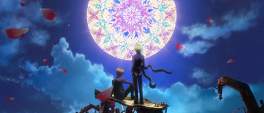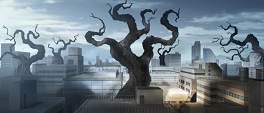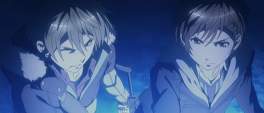First released: October 2012
Version reviewed: TV
Invoking Shakespeare in your story is risky business because like one comedian making reference to another, it invites comparison. And being compared to the stories of whom many would consider is one of the greatest writers ever is not a battle many writers are up for. This is true from a predominantly Western context, but from an Eastern point of view? A Japanese point of view? Shakespeare perhaps doesn’t hold the same reverence having not cast a shadow over several hundred years of literature.
This is all academic really because regardless of its overtures towards Shakespeare, Zetsuen no Tempest: The Civilization Blaster (Blast of Tempest) is below par. It starts out intriguingly enough with the awakening of something grand and unknowable leading to the quiet annihilation of an entire town. Only Mahiro survives thanks to his estranged friend Yoshino and a voice from afar, Hakaze. From there the trio must evade the attention of the Kusaribe clan and try and stop the awakening of an even greater power which threatens the world.
That’s all wrapped up by the halfway mark though. Job done, wash hands, moving on. Yes, in the grand tradition of twenty four episode series, episode twelve is when the show pivots and attempts to the drag the story through another twelve. In Tempest’s case though, even the recap episode buffer is welcome because from episodes eight through twelve, close to two hours of content, are spent on one of the most poorly conceived and utterly tedious “logic” battles ever imagined. The adventuring pair Yoshino and Mahiro stand on a hill in a forest, pointing a chained-up sub machinegun towards the very bishie Samon, whose assured, puppet-master facade is obliterated by him becoming flustered at the mewlings of two bizarrely well dressed teenagers.
Prior to that nonsense though is a compelling road-trip through a grey, wintery, near-disaster Japan where we learn through repeated flashbacks about the two boy’s histories, their relationship to the disembodied voice of Hakaze and, most importantly, the murder of Aika, Mahiro’s step sister and Yoshino’s late girlfriend.
The identity of who murdered her is the mystery that keeps the series stitched together: it gives the caustic and initially unlikable Mahiro an MO for getting involved with all this magic and clans and trees and wizards business, and also injects some drama as Yoshino tries to keep his amorous involvement with Aika a secret. To the series’ credit, when the mystery is solved it is a surprisingly satisfying conclusion to a story thread that could have easily sunk along with the rest of the plot. Of course by that point there is a giant tree that’s taken over the world, a flying wizard in a spiky super sentai costume and a dash of time-travel to keep things interesting.
The second half certainly needs it because without the antagonism of the Kusaribe clan that the first half had, there is very little drama to be gained from a quasi-sentient tree who may or may not be bringing about humanity’s downfall. Even Hakaze, who spent the first twelve episodes as a confident, self-sufficient young woman, is turned into a confused, love-struck teenager rather than the unstoppable magical force the story makes her out to be. Fundamentally, that’s what I signed up for with this series: that at some point the mage of Genesis and mage of Exodus (in the series’ parlance) would have a good ol’ magical scuffle and lay waste to a not insignificant chunk of Japan. Apart from a couple of very brief skirmishes though, all we get is a whole lot of words, repeated references to Shakespeare’s works and a rather tepid romantic drama.
Tepid because not only are the homoerotic undertones to Yoshino and Mahiro’s relationship played up significantly (“Once again, I am shirtless!”), but Yoshino is ferociously impassive to just about everything going on making it very difficult to sympathise with him. This is compounded by the tendency for both Yoshino and Mahiro to act like adults - drinking coffee, reading a newspaper etc. - yes still be only high school students, making their actions come across as somewhat disingenuous. Aika fares a lot better by virtue of being both capricious and intelligent, making her seductive without being over the top. Her death also evokes a kind of muted sadness that washes across the rest of the story like a distant shoreline. Unfortunately she is only “available” in flashbacks which, as a storytelling device, wear thin very quickly despite bolstering the theme of fate, replete with butterfly emblem, and its threads running from past to present and eventually affecting future.
Zetsuen no Tempest is an entertaining enough series that is hampered by protracted sequences of deductive battles - I’m loathe to call them battles of wits when everyone is demonstrated to be damn near witless - and a second half that never quite fulfills the promise that the first had. The magical mythology is pleasingly original but feels, perhaps purposely, limited in utility meaning practitioners are all lights and motion blur but no bite. The continued references to Shakespeare are the series’ greatest missteps with passages crowbarred into dialogue verbatim as well as allusions to Hamlet and, as one would expect, The Tempest doing absolutely no justice to their source material.
With enough patience and judicious “sprints” through the more laborious sections of the series, you could well come out the other end with an average experience of “enjoyable”. More often than not though, especially in the late teen episodes, I found myself just going through the motions, itching to find out what happened to Aika but caring little for the ongoing story arc. It’s a shame really because the atmosphere and styling of the earlier episodes is hugely enticing but steadily degrades along with the animation quality as the series progresses. There are aspects of brilliance in here - Aika’s character and storyline being one - but unfortunately they’re buried in amongst “Samon argues with teenagers” and “Diary of a whiny superhero”.
















